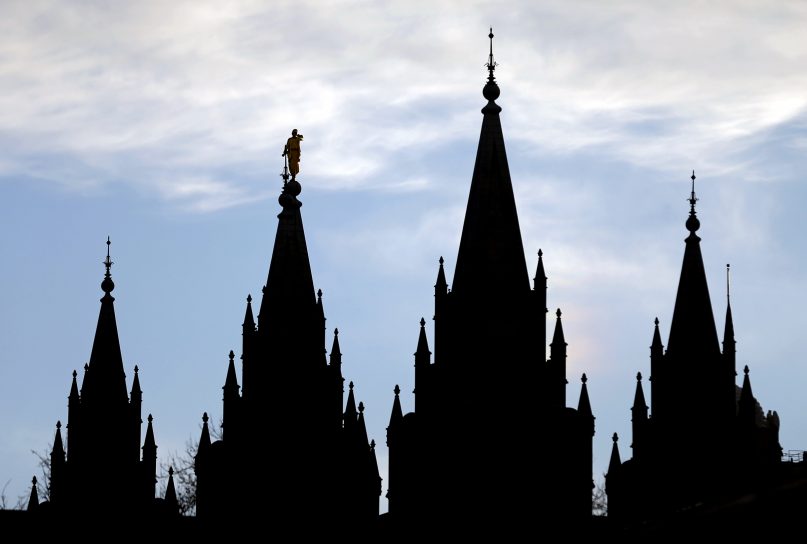(RNS) — The new theme for the Young Men organization of the Church of Jesus Christ of Latter-day Saints has been unveiled, to mixed reactions.
Some good news: it’s not just young women who are being primed to have a family someday. The revised theme tells teenage boys that they should “ prepare to become a diligent missionary, loyal husband, and loving father by being a true disciple of Jesus Christ.”
This means that both boys and girls (whose revised theme says that they are to “strengthen my home and family, make and keep sacred covenants, and receive the ordinances and blessings of the holy temple”) are expected to think early and often about family. If anything, the boys’ theme is more specific, steering them toward clear roles as husbands and fathers. This is surprising since the church has long placed a stronger focus on girls preparing to be wives and mothers.
On the other hand, the boys’ roles as outlined in the new YM theme offer other specific roles outside the family. From the very beginning, the boys’ revised theme emphasizes action: “He has a work for me to do.” Boys are to use the priesthood in service to God and others. They are expected, specifically, to serve a mission for the Church and to prepare for the Second Coming, neither of which is mentioned as a requirement for girls.
Girls have an equally noble but somewhat vaguer role, as they strive to become like Jesus and “seek and act upon personal revelation and minister to others in His holy name.”
I want to be clear here that I very much like the new YW theme. So far, these differences are fairly subtle, and we could even say that the YW theme is less restrictive — more open to individual circumstances, talents and desires — than the YM theme. (I do not believe, for example, that every human being should become a spouse and/or a parent. Not everyone is temperamentally suited for it; not everyone desires it; not everyone enjoys the financial and familial circumstances that facilitate parenting; and as the apostle Paul made clear, an unmarried state can be a holy vocation. The YW theme leaves the door open for individual variation, while the YM theme does not.)
The greatest difference, though, comes in the different ways the two themes envision God.
YW: “I am a beloved daughter of Heavenly Parents, with a divine nature and eternal destiny.”
YM: “I am a beloved son of God, and He has a work for me to do.”
Why does the girls’ theme mention Heavenly Parents — plural, including the holy Heavenly Mother — while the YM theme does not?
I think these tweets from Emily Jensen and Benjamin Park point to the underlying reason more succinctly and powerfully than any other discussion I’ve seen:

This is an issue of power and authority. If young Mormon males were to explicitly acknowledge Heavenly Mother every week in a devotional way, that would be an attribution of power — to a woman.
As I noted in September, this is a church in which young men are groomed again and again to believe that women are not equal in authority. Women are not present when the most important decisions are made in the administration of the church; if they are present in those meetings at all, it is by invitation and a matter of bishop roulette. Women’s advice may sometimes be sought, if a local leader is aware of the devastating potential effects of the usual imbalance of power, but that advice may just as easily be discarded. There is nothing in the handbook of the church that obligates men to regard women as equal.
This is what systemic inequality looks like. It is different from attitudinal sexism, which can be pervasive but is not codified, spelled out and binding. After I published that column I had several respondents who basically said, “Maybe, but sexism is everywhere,” and proceeded to tell me stories of sexism they had witnessed or experienced firsthand at work or school. They’re right, of course, but mere sexism was not what I was talking about. Systemic inequality is what is written into rules, guidelines, themes, creeds and laws to limit some individuals’ full participation based on gender, race, sexuality, or other criteria beyond their control. In the LDS Church, both problems are on offer: attitudinal sexism and systemic inequality.
What I wrote at the time was this:
“I’m sorry to be so blunt about it, but there is no way around the reality: Women do not lead men in this church. Ever. Women do not even lead teenage boys in this church. Starting from at least the age of 12, if not earlier, men are conditioned at church to see women as ancillary to decision-making.”
The new YM theme was an opportunity to prove me wrong — to demonstrate that, starting from the age of 12, Mormon men going forward would have a different sort of cultural conditioning, one that gives honor to their Heavenly Mother as much as to their Heavenly Father. And that beyond praising her, they would see her as a sacred authority, as teenage girls are implicitly encouraged to do in their theme.
It’s significant progress for “Heavenly Parents” to be in the YW theme for the first time in history. That’s not nothing. But the striking difference between that and the boys’ theme shows that in the LDS Church, there is still no situation in which males are under the authority of females.
Related posts:
A progressive Mormon’s top ten highlights of this weekend’s General Conference






